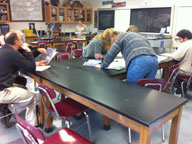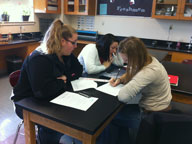 |
|
| SEARCH | MSTA 2010 | ||||||
|
Using Scientist Expertise and Concept Mapping to Bring Hot Topics into the Classroom COSEE-OS was delighted to present at the Maine Science Teachers Association (MSTA) conference on 11-Nov-10 . The materials shared at this conference are included here. For this session, we focused on two Research-Based Online Learning Event (ROLE) model webinars held during 2010. These are just a few examples from a wealth of resources that COSEE-OS has to offer! 
Hydrothermal Vent Ecosystems Webinar On 10-Aug-10, Dr. Peter Girguis (Harvard University) and Louise McMinn (Scofield Magnet Middle School) co-presented on science and education, respectively. Dr. Girguis presented an interactive concept map he developed to illustrate deep-sea hydrothermal vent ecosystems, his area of expertise. Louise McMinn shared her experiences using concept maps to frame an multi-faceted project on water quality.
Activity #1: FLEXE - From Local to EXtreme Environments. From From Local to Extreme Environments (FLEXE) involves study of the deep ocean. The "Ecology Unit" contains eight activities that can be downloaded separately. During the MSTA meeting, participants focused on "Activity 2: FLEXE Forum – How Ecologists Study the Deep Seafloor: Using Photomosaics to Understand Animal Distribution." In this activity, Dr. Chuck Fisher from Penn State University posts a dataset featuring the distribution patterns of organisms around hydrothermal vents along with probing questions to guide analysis. Learners work offline to interpret the data and answer questions. Once completed, learners review Dr. Fisher's feedback on the activity online. Key concepts include: 1) Remote environments such as the deep-sea present unique challenges to research; and 2) The distribution of organisms is influenced by many factors, both biotic and abiotic. 
Sequestered Carbon and the Carbon Cycle Webinar On 06-Oct-10, Dr. Larry Mayer (University of Maine) presented a set of interactive concept maps that show how carbon moves between air, sea and sediment in earth systems. He illustrated current best estimates about "standing stock" of carbon in different locations and forms, and illustrated rates of transfer between, and the residence times in, each location. One educator, Ted Taylor (Bangor High School), was inspired by Dr. Mayer's talk to consider how to create "simple but layered" concept maps with his students.
Activity #2: Residence Times - How Long Does Carbon Stay? Based on Dr. Mayer's webinar presentation, this activity challenges learners to use information on carbon inventories and flux rates in the atmosphere, ocean, and sediments to hypothesize about the relative residence times in each of these reservoirs. Other Teaching Resources Related to this Topic:
"Hot" New Educational Resources Related to the Ocean
|
|
|||||||




